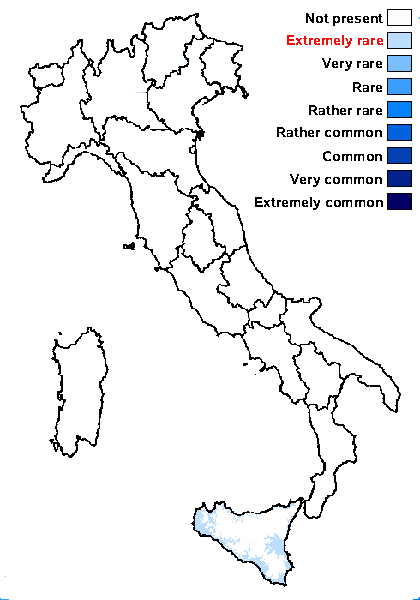Waynea giraltiae van den Boom
Lichenologist, 42: 30, 2010
Synonyms:
Distribution: S - Si (Ravera & al. 2018).
Description: Thallus minutely squamulose, greenish grey, yellowish brown or medium brown, dull, the squamules scattered to crowded, often aggregated in patches, flat to slightly convex, contiguous to ascending and imbricate, 0.1-0.5 mm wide, the largest ones often incised, esorediate, finely tomentose, the tomentum hardly visible with a hand-lens, consisting of hyaline hyphae protruding from cortex. Upper cortex prosoplectenchymatous, 25-35 μm thick, without crystals; medulla white, of loosely interwoven hyphae with rectangular cells; lower cortex absent. Apothecia biatorine, adpressed to sessile, grey, dark brown or black, often piebald, epruinose, 0.2-0.9 mm across, with a concave to flat disc, and a concolorous, at first thick, then less evident proper margin. Proper exciple colourless or violet-grey in upper part, prosoplectenchymatous, the pigmented parts K+ violet; epithecium colourless to pale olivaceous or violet grey, the pigmented parts K+ violet, N+ purple; hymenium colourless, 35-50 μm high; paraphyses coherent, simple or sparingly furcate in upper part, 2-2.5 μm thick at mid-level, the apical cells up to 5 μm wide, surrounded by a thin, pigmented, gelatinous matrix; hypothecium colourless, subtended by an algal layer. Asci 8-spored, clavate, distinctly thickened at apex, with an I+ blue tholus, the outer gelatinous coat I+ pale blue, Bacidia to Biatora-type. Ascospores (1-)3-septate, hyaline, fusiform, 12-18 x 2-2.5 μm. Pycnidia rare, immersed, colourless or pale brown in upper part, 35-50 μm across. Conidia filiform, strongly curved, 20-29 x c. 0.5 μm. Photobiont chlorococcoid. Spot tests: thallus K-, C-, KC-, P+ orange-red. Chemistry: thallus with argopsin; exciple and epithecium with the Sedifolia-grey pigment.Note: a species known from the Iberian Peninsula (Spain, Portugal), growing on old oaks at low altitudes. The only Italian record is from Mt. Etna, at 1500 m, on Quercus congesta.
Growth form: Squamulose
Substrata: bark
Photobiont: green algae other than Trentepohlia
Reproductive strategy: mainly sexual
Commonnes-rarity: (info)
Alpine belt: absent
Subalpine belt: absent
Oromediterranean belt: absent
Montane belt: absent
Submediterranean belt: absent
Padanian area: absent
Humid submediterranean belt: absent
Humid mediterranean belt: extremely rare
Dry mediterranean belt: extremely rare

Predictive model
Growth form: Squamulose
Substrata: bark
Photobiont: green algae other than Trentepohlia
Reproductive strategy: mainly sexual
Commonnes-rarity: (info)
Alpine belt: absent
Subalpine belt: absent
Oromediterranean belt: absent
Montane belt: absent
Submediterranean belt: absent
Padanian area: absent
Humid submediterranean belt: absent
Humid mediterranean belt: extremely rare
Dry mediterranean belt: extremely rare

Predictive model
 INDEX FUNGORUM
INDEX FUNGORUM
 GBIF
GBIF

